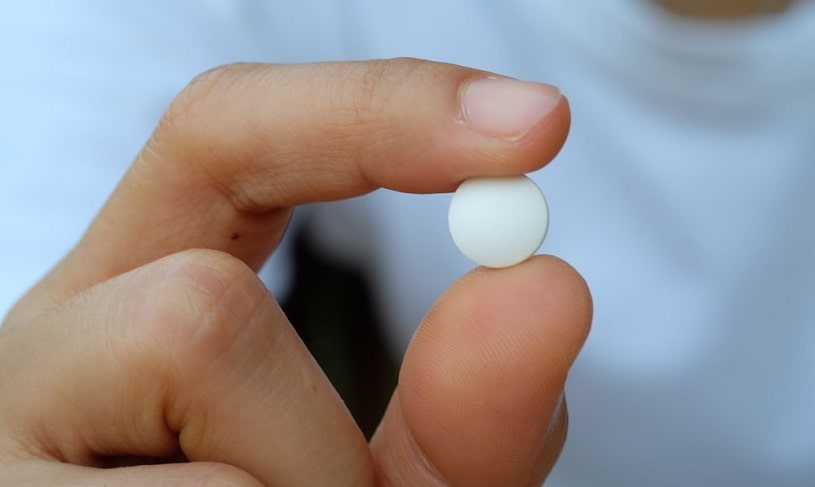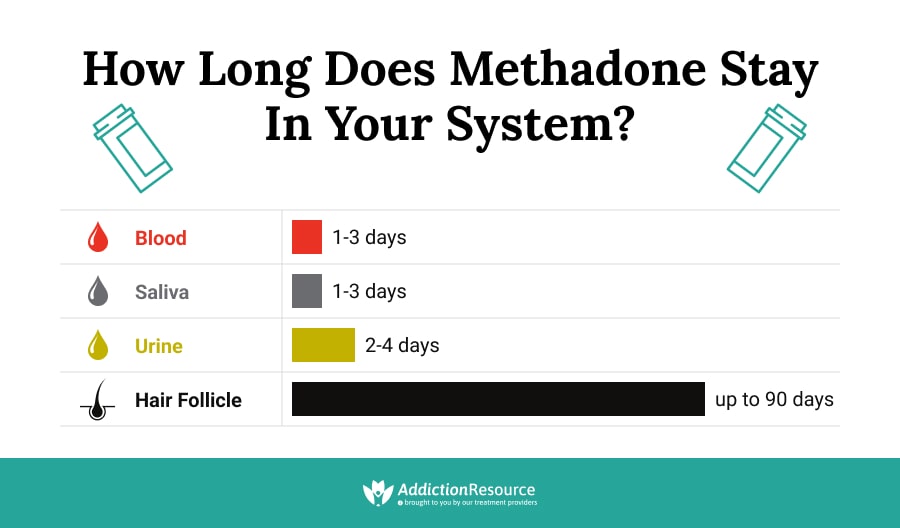
Methadone (Dolophine) is a synthetic opioid used in the treatment of several health conditions such as moderate to severe chronic pain and opioid dependence. According to most resources, the half-life is 8-59 hours, which means that one might need between 1 and 14 days to get the drug out of their system.
Table Of Contents:
Many factors can affect the Methadone half-life, its duration within the body, and elimination time. Dosage, age, body mass, health status, metabolic rates, and diet are among the variables that affect the drug and its effects.
So, how long does methadone stay in your system? What drugs can cause a false-positive result? How is it metabolized, and how does Methadone work?
Methadone Half-Life
The half-life of Methadone is 8-59 hours. This extensive variation in the Methadone half-life is due to several factors that may affect the half-life of Methadone. Some of them include the dose taken, the route of administration, the frequency of use, the age, body mass, health status, genetic makeup of the patient, and the concurrent use of other drugs.
One advantage of the long half-life of Methadone is that it allows it to be used in the treatment of opioid dependence as it can be made into a once-daily dosage formulation. It allows it to delay the onset of withdrawal symptoms but causes significantly fewer effects than shorter-acting opioids.
However, the long Methadone half-life is not without disadvantages. A long half-life means that it can accumulate within the body of the patient, making dosing it in patients who are intolerant difficult. Another disadvantage of this long half-life is that prolonged intervals of toxicity which may last as long as several days after contact with the medication requiring prolonged care.
How Does Methadone Work?
The question can be answered by its receptor interactions within the brain. It is a strong synthetic analgesic that acts as a µ-opioid receptor agonist and an N-methyl-d-aspartate receptor antagonist. As a µ-opioid receptor agonist, the medication can precisely reproduce the natural effects of opioids, enkephalins, and endorphins in the body by releasing neurotransmitters responsible for pain transmission.
The Methadone mechanism of action also comes with its characteristics, especially the decreased risk of neuropsychiatric toxicity (because it lacks active metabolites), good bioavailability, long duration of the activity, and minimal accumulation in renal failure.
The Methadone mechanism of action shares similarities with other opioids, including fentanyl, oxycodone, hydromorphone, and morphine. However, it also has a unique pharmacokinetic profile providing a longer half-life and duration of action.

This makes its use effective, particularly in the management and care of pain syndromes, which are hard to treat, including cancer and neuropathic pain for which it is needed more frequently and higher doses of shorter-acting opioids. It is also helpful in the treatment of addiction, preventing opioid withdrawal symptoms.
What is the downside? The half-life is unpredictable and interindividual variability. These characteristics can increase the risk of an overdose or respiratory depression when titrating or initiating the therapy.
Does the Opioid Show Up on Drug Tests?
The opioid is not routinely tested for on standard drug test kits but can be detected by special testing kits. Despite this, Dolophine tests may be required by employers, law enforcement officials, athletic organizations, and drug rehabilitation programs.
How Long Does Methadone Stay in Your System?
The answer depends on several factors. The opioid stays within the body longer than most opioids due to its long half-life. Generally, the opioid can remain in the body for as long as 2-13 days after initial contact depending on the medication’s half-life within the individual and the body sample tested. Due to the higher variability of its half-life between different patients, this range may be much longer or shorter.

Usually, patients feel the effects of Methadone within 30 minutes, but the peak effects occur approximately 3 hours after taking the medication. However, its full effects do not begin for about 3-5 days of treatment.
How Long Does It Stay in Blood?
The opioid is potent, and peak plasma concentrations occur within four hours. Blood tests are not so standard when it comes to Dolophine detection. However, the medication is still in the blood even 30 minutes after intake and up to a few days.
How Long Does It Stay in Saliva?
Oral samples also can detect the opioid, and just like blood tests, they can detect the medication in 30 minutes and up to a few days after ingestion.
How Long Does It Stay in Hair?
Although it takes some time for the opioid to accumulate in hair segments, professionals can detect regular use via hair tests, with a detection window of up to 90 days.
How Long Does It Stay In Urine?
Urine tests are among the most reliable techniques to detect the drug for up to 2-4 days. The cut-off levels are at 300ng/mL. Some resources claim that the drug can be detectable for up to two weeks after intake.

Methadone Elimination: Factors to Consider
As stated above, the range of Methadone half-life is broad. That’s because many factors affect the duration and the elimination of the medication.
These Factors Include:
- Dosage: Greater amounts of medication will excrete slower.
- Frequency: Frequent use will lead to increased accumulation of the medication in the body.
- The way of administration: Injecting leads to a quicker peak. Note that injecting the substance can also lead to vein thrombosis and infections.
- Age: Users over 65 metabolize the drug at lower rates.
- Body mass: As the substance accumulates in fat deposits, users that weigh less will remove from their system quicker.
- The health of the user: Problems with the liver and the kidneys may result in slow elimination.
- Genetics: Some genes can affect the user’s metabolic rates, resulting in rapid or slow metabolizers.
- Lifestyle: Specific diet may affect the duration and elimination of the drug. For instance, acidic meals may lead to quicker excretion.
- Polydrug abuse: Do not forget that mixing the substance with other drugs is dangerous as it may lead to an overdose. Other drugs may affect the chemical balance, resulting in a slow elimination. So if one is undergoing Methadone maintenance treatment, it’s essential not to take other drugs or alcohol during the treatment process.
It’s important to say that pregnant women can clear their system quicker than non-pregnant. Information on the topic is vital as many addicted pregnant women use the opioid during pregnancy.
Methadone False Positive
Several drugs have been associated with Methadone false-positive urine drug tests. These include Vortioxetine and Quetiapine. This information is essential as a patient on any of these drugs may have false-positive results even if they have not come in contact with the drug recently.
Dealing With Opioid Dependence
The medication is considered helpful in dealing with opioid withdrawal and encouraging safe opioid detoxification. This is because the drug has a long half-life allowing once-daily dosing and causes significantly reduced effects such as euphoria, psychomotor effects, and dependence. However, Methadone addiction can occur when the drug is misused or used at much higher doses. In this situation, the detox is prolonged due to its long half-life and potential to accumulate within the body. That’s why it is best to contact a professional drug rehabilitation center that can provide you with the medical care, information, resources, and support you need to rid your body of the drug safely, deal with Methadone withdrawal symptoms, and finally overcome your opioid addiction.
Hope Without Commitment
Find the best treatment options. Call our free and confidential helpline
Most private insurances accepted
Find Drug Rehabilitation Centers Near You Anywhere In the US
Addiction Resource team has compiled an extensive list of the top drug rehabilitation facilities around the country. Use our locator tool to find the best centers near you.
Page Sources
- National Center for Biotechnology Information (2021). PubChem Compound Summary for CID 4095, Methadone. https://pubchem.ncbi.nlm.nih.gov/compound/Methadone.
- Jarvis, M. A., Wu-Pong, S., Kniseley, J. S., & Schnoll, S. H. (1999). Alterations in methadone metabolism during late pregnancy. Journal of addictive diseases, 18(4), 51–61. http://www.ncbi.nlm.nih.gov/pubmed/10631963
- Durrani M, Bansal K. Methadone. [Updated 2021 Feb 18]. In: StatPearls [Internet]. Treasure Island (FL): StatPearls Publishing; 2021 Jan-. Available from: https://www.ncbi.nlm.nih.gov/books/NBK562216/
- Australian Government, Department of Health, Clinical Guidelines And Procedures For The Use Of Methadone In The Maintenance Treatment Of Opioid Dependence, 2003. https://www1.health.gov.au/internet/publications/publishing.nsf/Content/drugtreat-pubs-meth-toc~drugtreat-pubs-meth-s1
- Anderson, I. B., & Kearney, T. E. (2000). Use of methadone. The Western journal of medicine, 172(1), 43–46.https://www.ncbi.nlm.nih.gov/pmc/articles/PMC1070723/
- Clinical Guidelines for Withdrawal Management and Treatment of Drug Dependence in Closed Settings. Geneva: World Health Organization; 2009. 6, Methadone maintenance treatment. https://www.ncbi.nlm.nih.gov/books/NBK310658/
- Uljon, S., Kataria, Y., & Flood, J. G. (2019). Vortioxetine use may cause false positive immunoassay results for urine methadone. Clinica chimica acta; international journal of clinical chemistry, 499, 1–3. https://pubmed.ncbi.nlm.nih.gov/31469980/
- Widschwendter, C. G., Zernig, G., & Hofer, A. (2007). Quetiapine cross reactivity with urine methadone immunoassays. The American journal of psychiatry, 164(1), 172. https://pubmed.ncbi.nlm.nih.gov/17202566/


 Reviewed by:
Reviewed by:  Written by:
Written by: 

 FindTreatment.gov
FindTreatment.gov